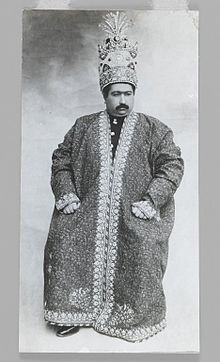Kiani Crown
In today's world, Kiani Crown has become a topic of great interest to many people. Whether due to its historical relevance, its impact on current society or its influence in various areas, Kiani Crown is a topic that leaves no one indifferent. Throughout history, Kiani Crown has been the object of study, debate and reflection, and its importance remains valid today. In this article, we will explore different aspects related to Kiani Crown, analyzing its relevance and impact in the contemporary world.
This article needs additional citations for verification. (August 2021) |
| Kiani Crown | |
|---|---|
 Replica of Kiani Crown | |
| Details | |
| Country | Iran |
| Made | 1796 |
| Material | Gold, silver |
| Cap | Red Velvet |
| Notable stones | Pearl, diamond |

The Kiani Crown (Persian: تاج کیانی) was the traditional coronation crown in the Iranian Crown Jewels, worn by the Qajar shahs of Iran (1789–1925). The crown was designed under the first Qajar shah Agha Mohammad Khan Qajar (r. 1789–1797) as a way to connect himself to the ancient Sasanian shahs (224–651) and mythological Kiyani shahs.
The crown itself is made of red velvet, on which thousands of gems were set. The Kiani Crown is highly decorated, possessing 1800 small pearls stitched onto it, with many having only 7 millimetres in diameter. It has approximately 300 emeralds and 1,800 rubies. The crown is 32 cm (12.5 in.) high and 19.5 cm (7.5 in.) wide. It is currently kept in the National Treasury of Iran in Tehran.
Reza Shah, the founder of the Pahlavi dynasty, had his own Pahlavi Crown designed, but the Kiani Crown was present during his coronation in 1926.
Middle and New Persian kay(an) originates from Avestan kavi (or kauui) "king" and also "poet-sacrificer" or "poet-priest".
See also
References
- ^ Daryaee 2016, p. 42.
Sources
- Daryaee, Touraj (2016). "Persianate Contribution to the Study of Antiquity: E'temad Al-Saltaneh's Nativisation of the Qajars". Iran: Journal of the British Institute of Persian Studies. 54 (1): 39–45. doi:10.1080/05786967.2016.11882299.
External links
 Media related to Kiani Crown at Wikimedia Commons
Media related to Kiani Crown at Wikimedia Commons- Image of the Kiani Crown